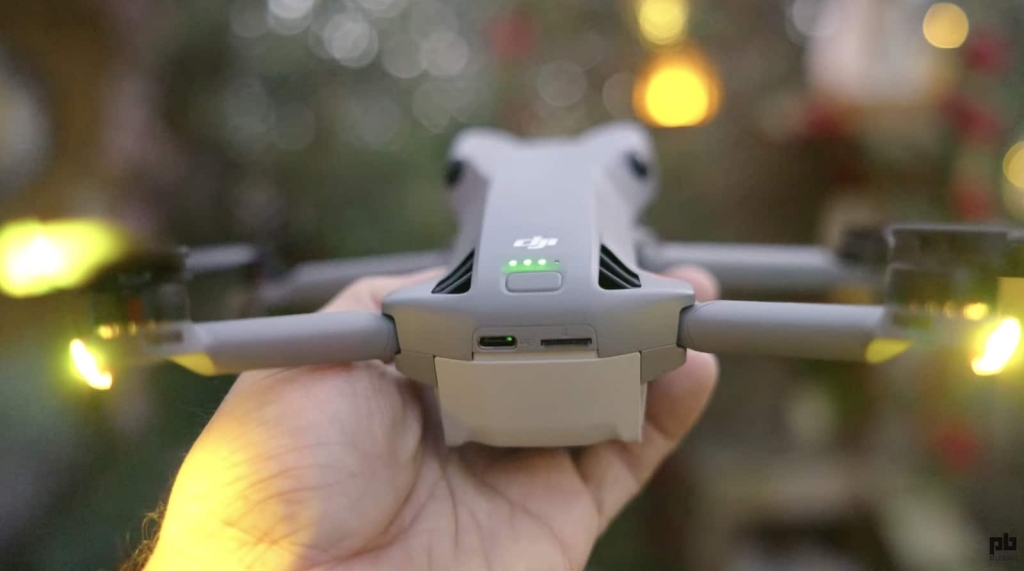DJI Mini 5 Pro: Philip Bloom’s Comprehensive Review Unveils Game-Changing Features For Drone Pilots
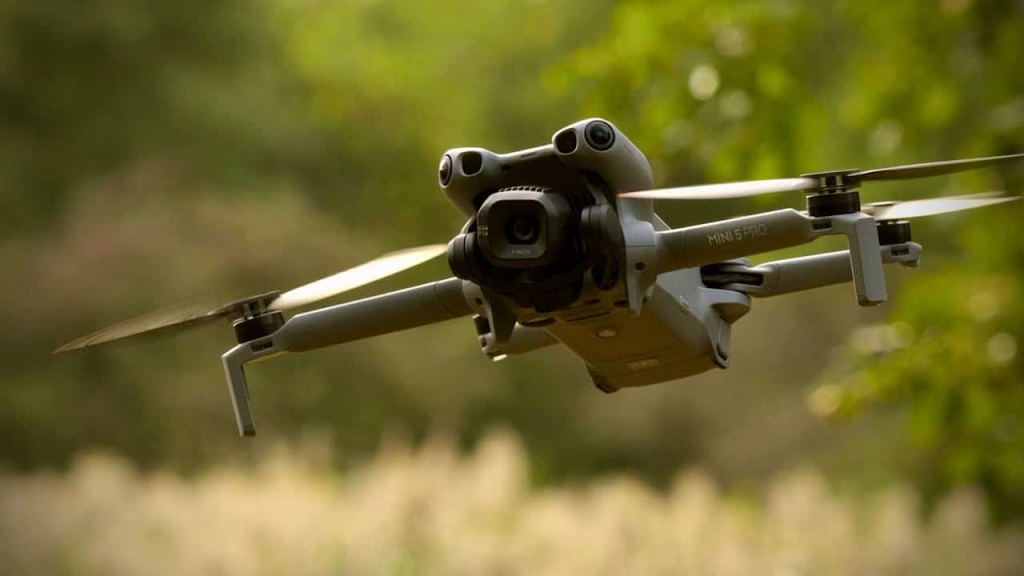
Amazon DEALS: DJI Mini 4K now $249 (-17%) and DJI Osmo Action 4 drops to $249!
Renowned filmmaker and drone expert Philip Bloom has released an exhaustive review of the new DJI Mini 5 Pro, meticulously dissecting its advancements in sensor technology, obstacle avoidance, and overall imaging capabilities. This latest iteration from DJI is poised to redefine expectations for sub-250-gram or near-250-gram drones, aiming to deliver professional-grade features to a broad audience of aerial cinematographers and enthusiasts.
Bloom’s in-depth analysis, presented in his recent video, offers invaluable insights into how these significant upgrades translate into tangible, real-world performance for drone operators. For pilots navigating the competitive landscape of compact drones, his findings are crucial for understanding whether the Mini 5 Pro’s enhanced camera—which shares specifications with the larger DJI Air 3S—justifies an upgrade and if DJI has successfully integrated high-end functionality into a drone that remains compliant with stringent weight-based regulations.
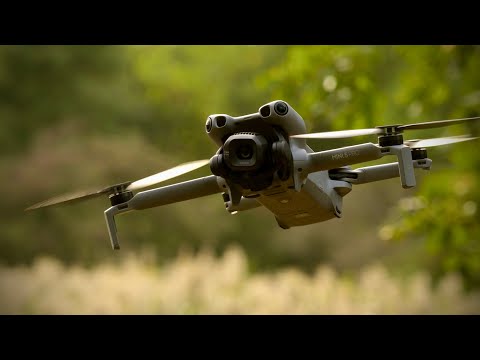
Design Evolution and Core Enhancements
The DJI Mini 5 Pro presents a refined aesthetic, featuring a darker gray finish that aligns it visually with DJI’s more professional-grade offerings, including the Air 3, Air 3S, and Mavic 4 Pro. This cosmetic update, however, merely hints at the more profound improvements beneath its sleek exterior. According to Bloom’s assessment, the DJI Mini 3 Pro previously marked a pivotal advancement from the Mini 2, primarily due to its larger sensor. The Mini 5 Pro builds upon this legacy, introducing significantly enhanced forward and backward obstacle avoidance sensors. These are complemented by advanced in-app controls for sharpness and noise reduction, collectively designed to bolster the drone’s imaging prowess and operational safety across diverse flight scenarios.
Further solidifying its position as a top-tier compact drone, the Mini 5 Pro incorporates added side sensors, expanding its environmental awareness. Its video capabilities now extend to 4K resolution at 60 frames per second (fps) in both HLG (Hybrid Log-Gamma) and D-Log M color profiles, offering greater flexibility for post-production grading. The drone also features the superior O4 transmission system, with the 5 Pro benefiting from an even better O4 Plus transmission, ensuring robust and reliable connectivity over extended ranges. Bloom emphasizes that while some of these enhancements are incremental refinements, others represent substantial leaps forward, culminating in a more sophisticated and user-friendly flying and filming experience for pilots.
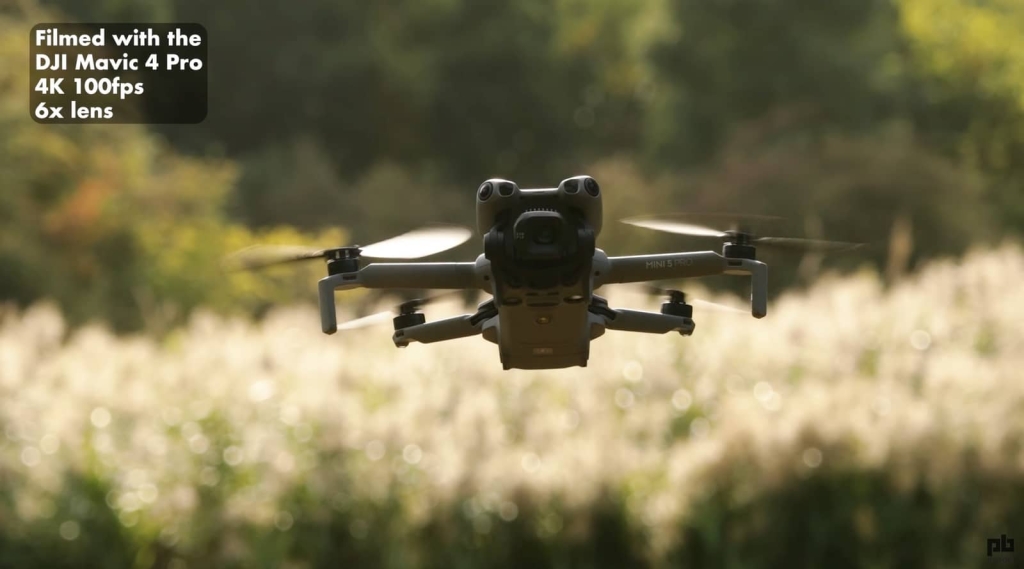
The Revolutionary 1-Inch Sensor: A Deep Dive into Imaging
Undoubtedly, the most compelling feature of the DJI Mini 5 Pro is its newly integrated 1-inch sensor, a substantial upgrade from the 1/1.3-inch sensor found in its predecessors. Philip Bloom posits that this sensor is likely the same quad-Bayer Sony sensor employed in the Air 3S, although official confirmation from DJI is still pending. This increase in sensor size is not merely a number; it translates directly into a 1.6 times larger surface area compared to the Mini 4 Pro. This physical enlargement is critical, as a larger sensor with larger individual pixels inherently promises superior light gathering capabilities, leading to improved dynamic range and a noticeably cleaner image, particularly in challenging lighting conditions.
Bloom vividly illustrates this improvement through practical examples. He notes that even when shooting at a fast shutter speed of 1/8000th of a second in D-Log M at ISO 100, the image quality remains commendable, effectively preserving detail even with the sun directly within the frame—a scenario that typically results in blown-out highlights. However, the true transformative power of the new sensor, combined with intelligent processing, becomes strikingly evident when engaging the drone’s Auto ISO feature. With Auto ISO activated, Bloom observes a dramatic improvement in shadow detail, revealing information that would otherwise be lost in darker areas of the scene. This intelligent system, which dynamically combines high and low ISOs, was a feature first introduced with the Mavic 4 Pro and is now refined in the Mini 5 Pro, proving crucial for achieving optimal dynamic range in varied lighting.
Bloom’s rigorous controlled tests further corroborate the Mini 5 Pro’s advanced capabilities. By comparing its dynamic range against the Mini 4 Pro using both manual exposure settings and the Auto ISO feature, he found the results compelling. While DJI officially claims up to 14 stops of dynamic range for both models, Bloom’s real-world testing consistently showed the Mini 5 Pro outperforming its predecessor. Specifically, in the D-Log M profile, the 5 Pro demonstrated superior highlight retention, preventing overexposure in bright areas, and simultaneously preserved more intricate detail within the shadows. Visual corroboration, particularly when examining the sky in test footage and analyzing waveform data, unequivocally revealed that the Mini 4 Pro’s highlights frequently clipped, whereas the Mini 5 Pro adeptly maintained them, showcasing a remarkable testament to its advanced sensor and sophisticated image processing algorithms.
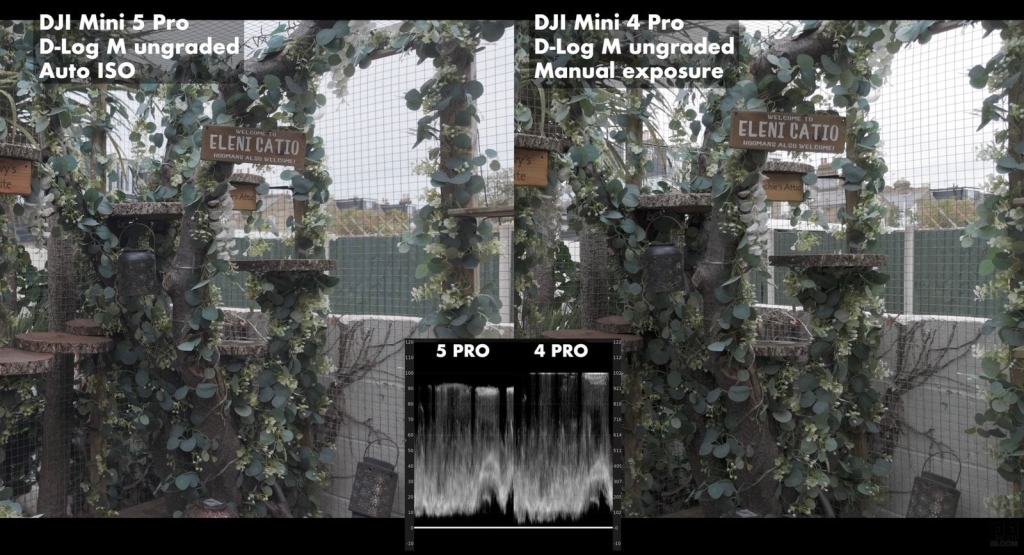
It is, however, an important nuance to highlight that this advanced Auto ISO functionality is exclusively available in the 1x zoom mode. Despite this limitation, its effectiveness extends to both HLG and standard color profiles, where the improvements in image quality are distinctly visible and beneficial for creators. A comparative test conducted by Bloom using the Air 3’s main camera, which is technically identical to the Mini 5 Pro’s camera, further reinforced these observations. While the Air 3 also demonstrated benefits from its Auto ISO behavior, the Mini 5 Pro consistently exhibited superior performance in both shadow and highlight recovery. Consequently, Bloom concludes that Auto ISO, despite being an automatic exposure setting he typically prefers to avoid for maximum creative control, emerges as a necessary and highly effective tool for maximizing the Mini 5 Pro’s dynamic range and overall image fidelity.
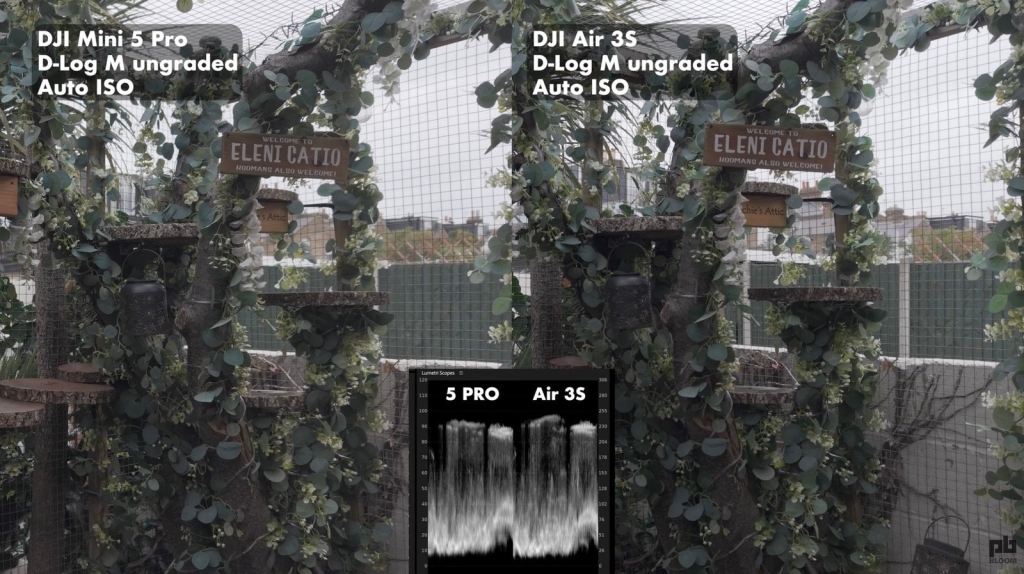
ISO Limitations and Evolving Color Profiles
A point of contention for Philip Bloom, and likely for many professional cinematographers, lies in the Mini 5 Pro’s manual ISO settings. The drone continues to operate exclusively in full-stop increments (e.g., ISO 100, 200, 400), a limitation that stands in stark contrast to the Mavic 4 Pro, which finally introduced 1/3-stop increments. This finer control over exposure is not merely a convenience; it is a critical requirement, especially for cameras with fixed apertures like the Mini 5 Pro, where the ability to precisely dial in exposure settings is paramount for achieving desired visual outcomes. The only current method to access intermediate ISO values is through the drone’s Auto ISO feature, which, while effective for dynamic range, sacrifices the granular manual control many professionals demand. Bloom has openly expressed a strong desire for DJI to address this limitation through a firmware update, ideally implementing 1/3-stop ISO increments across its entire drone lineup.
In terms of color profiles, a significant new addition to the Mini series is the inclusion of a 10-bit normal color profile. While this technical upgrade is generally welcomed for its potential to capture a wider range of colors and tones, Bloom advises a degree of caution in its application. He finds this profile to be excessively contrasty and overly sharpened for his personal preferences, which lean towards a more natural, less processed image that offers greater flexibility during post-production color grading. Bloom consistently maintains minimum sharpness and noise reduction settings across all his chosen profiles, underscoring his philosophy of capturing the cleanest possible image data for subsequent manipulation in editing software.
Advanced Obstacle Avoidance and Intelligent Tracking Performance
The DJI Mini 5 Pro significantly elevates its safety and operational intelligence by inheriting the sophisticated front-facing ladder sensor system from the Air 3S and Mavic 4 Pro. This advanced sensor array dramatically enhances the drone’s obstacle avoidance capabilities, providing a more robust and reliable flight experience. The improvement is not confined to low-light conditions; it proves equally effective in normal daylight, adeptly detecting and navigating around obstacles that might otherwise be missed by less sophisticated conventional sensors. Philip Bloom, who routinely employs ActiveTrack during his drone reviews to rigorously test tracking performance, was particularly impressed with the Mini 5 Pro’s ability to follow subjects with precision, even when navigating through complex and challenging environments such as densely wooded areas.
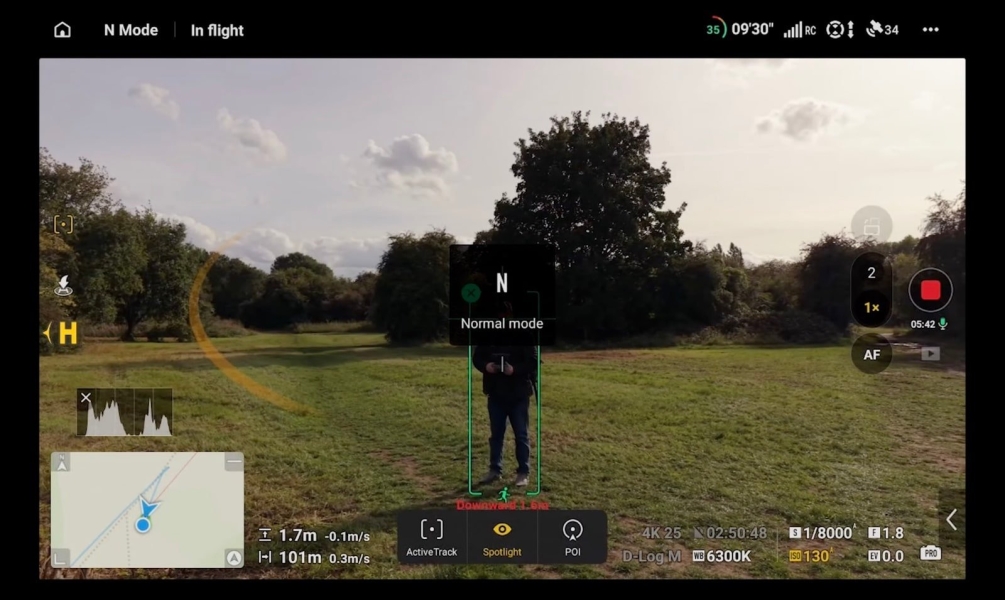
Bloom’s preferred tracking mode, Spotlight, allows the drone to maintain a chosen subject within the frame while the pilot retains independent control over the drone’s flight movements. This feature is highly valued for its ability to simplify complex shots. However, Bloom identified a notable operational anomaly: the drone would not execute movements in Cine mode while Spotlight was active. To circumvent this, he was compelled to switch the drone to Normal mode and then manually adjust the gain and expo settings within Normal mode to meticulously match the slow, cinematic speed of 1 meter per second (approximately 3.3 feet per second) typically associated with Cine mode. This workaround allowed him to achieve the desired smooth tracking shots. Bloom expresses a strong hope that this behavior is a software bug that DJI will promptly address in a future update, as it represents a deviation from the expected functionality observed in other DJI drone models.
Innovative Zoom and High-Resolution Capabilities
One of the most compelling innovations highlighted by Bloom in the Mini 5 Pro is its intelligent utilization of the quad sensor to achieve a tighter field of view while meticulously preserving resolution. The drone is equipped with an 8K quad sensor. Traditionally, the pixels within such a sensor are combined (pixel-binned) to produce standard 4K footage. However, the Mini 5 Pro introduces a distinct advantage: it can sample the sensor on a one-to-one basis to directly deliver 4K footage. This method, while offering a tighter perspective, can result in slightly noisier footage due to the absence of pixel-binning’s noise reduction benefits. Consequently, Bloom advises pilots to maintain a low ISO and to judiciously avoid challenging lighting scenarios, particularly those involving bright backlighting coupled with dark subjects, to preserve optimal dynamic range and image cleanliness.
During his testing, Bloom noted the presence of some minor digital artifacts in both the 1x and 2x zoom modes. These artifacts became more pronounced when the footage was digitally punched in, though he attributes their appearance primarily to compression and the inherently challenging nature of specific shots rather than a fundamental flaw in the sensor. The 2x zoom feature proves exceptionally practical for rapidly achieving tighter compositions and capturing unique perspectives that would be otherwise unattainable by simply flying the drone closer to the subject. While the image quality in 2x mode is a marginal step down from the native 1x mode, it significantly outperforms digital zooms found in earlier models like the Mini 4 Pro or those achieved through post-production cropping. The Mini 5 Pro also offers a 3x digital zoom, which Bloom suggests is best reserved for post-editing adjustments rather than in-camera use.
Enhanced Onboard Storage and MicroSD Card Recommendations
A welcome and practical improvement in the Mini 5 Pro is the substantial increase in onboard storage, expanding from a rather impractical 2 gigabytes (GB) to a much more usable 42 GB. Despite this significant upgrade, Philip Bloom continues to primarily rely on external microSD cards for all his recording needs, citing two primary reasons for this preference. He highlights Lexar as a sponsor, specifically endorsing their Silver Plus line of microSD cards, which have received full approval from DJI for use with their drones. These high-performance cards boast impressive read speeds of up to 205 megabytes per second (MB/s) and write speeds of up to 150 MB/s, making them more than capable of handling the drone’s maximum H.265 bitrates without compromise. Bloom underscores the critical importance of durability for these compact microSD cards, noting Lexar’s claims of eight different proofs against environmental factors, though he has not personally conducted tests to verify these claims. For his drone operations, he typically utilizes 128 GB cards, finding this capacity more than sufficient for the footage captured during a single battery’s flight duration. He also reiterates a long-standing and crucial piece of drone advice: always swap your microSD card when changing batteries. This practice serves as a vital safeguard against potential data loss should an unforeseen incident occur during subsequent flights.
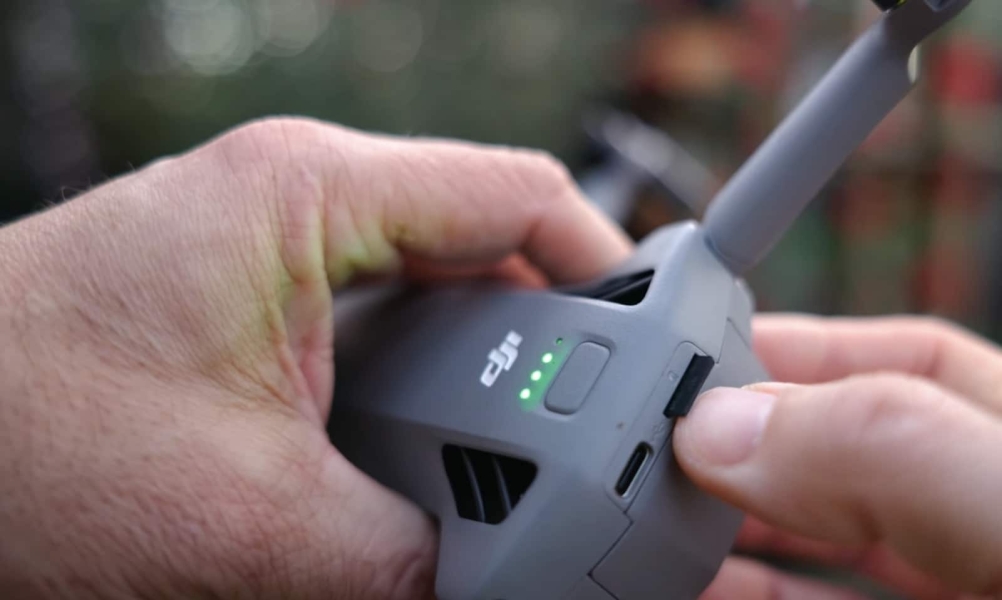
The Rise of Vertical Video and Gimbal Innovations
Regardless of personal preference, vertical video has firmly established its presence in the contemporary media landscape. The Mini 5 Pro adeptly accommodates this trend by allowing its gimbal to rotate 90 degrees, a feature carried over from its predecessor. This functionality is achieved by pausing recording, physically rotating the gimbal, and then resuming the recording process. While Bloom acknowledges the growing aesthetic appeal and utility of vertical compositions, he personally expresses a preference for traditional landscape orientation. He points out a critical technical limitation: cropping a landscape image to a vertical format inevitably results in a vertical resolution of only 1920 pixels. While this resolution may suffice for social media platforms, it is often insufficient for delivering high-quality 4K files required for more professional applications. The Mini 5 Pro’s ability to capture native 4K vertical footage by rotating the gimbal is therefore a significant advantage for clients or projects specifically demanding such formats.
Drawing inspiration from the Mavic 4 Pro, the Mini 5 Pro’s gimbal boasts an impressive rotational range of 225 degrees, enabling the capture of highly dynamic and unique shot compositions. While this extended rotational capability is undoubtedly a ‘cool’ feature, Bloom articulates a preference for a drone equipped with a square sensor, similar to those found in devices like the Osmo 360. He elaborates that a square sensor, for instance, with dimensions of 3840×3840 pixels, would offer unparalleled flexibility. Such a sensor would allow for seamless cropping to various aspect ratios—vertical, horizontal, 4×3, 2.35:1, or 5:1—all while consistently maintaining a 3840-pixel (4K) longest edge. Bloom highlights that square sensors have previously appeared in other cameras, including the 360 Go series, and have even been adopted by Apple for its front-facing cameras, suggesting that this design represents an ideal and future-proof solution for drone cameras.
Lens Specifications, Aperture Dynamics, and Enhanced Slow Motion
Both the DJI Mini 4 Pro and the Mini 5 Pro are equipped with lenses labeled as 24mm equivalent. However, a subtle distinction exists: the Mini 4 Pro offers a marginally wider 2-degree field of view, a difference that Philip Bloom considers to be negligible in practical application. Regarding aperture, the Mini 4 Pro features an f/1.7, while the Mini 5 Pro has an f/1.8. Bloom clarifies that this difference is relative to their respective sensor sizes and does not necessarily imply that the 4 Pro possesses a genuinely larger aperture in terms of light-gathering capability. A more impactful improvement in the Mini 5 Pro is its significantly reduced minimum focus distance, now 50 centimeters (approximately 1.6 feet), down from the Mini 4 Pro’s 1 meter (approximately 3.3 feet). This shorter minimum focus distance is particularly advantageous for achieving aesthetically pleasing bokeh effects, allowing for more creative depth-of-field control.
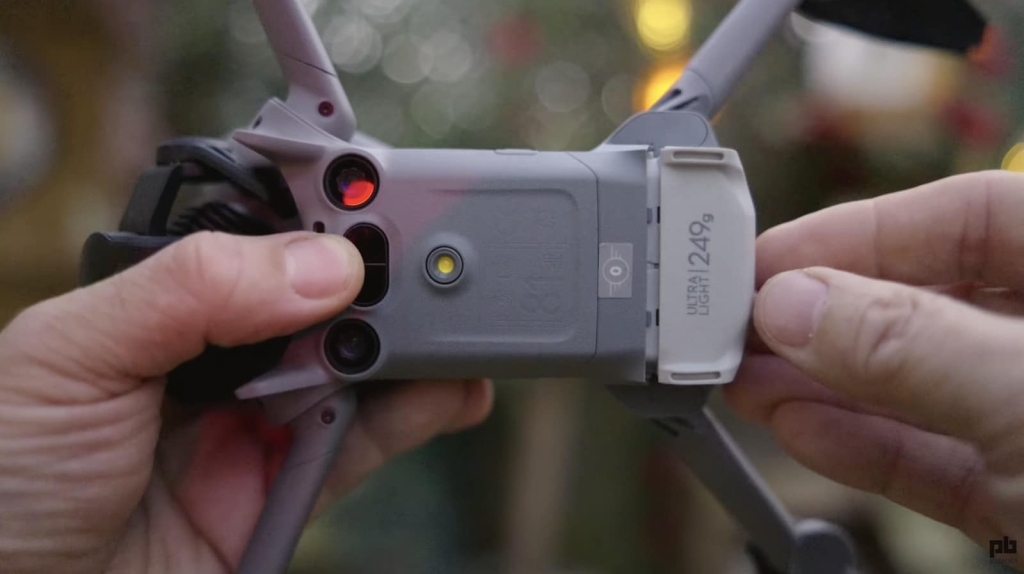
Slow-motion capabilities have also received a substantial upgrade in the Mini 5 Pro. The drone can now capture stunning 4K footage at 120 frames per second (fps) and 1080p footage at an impressive 240 fps. These figures represent a notable increase from the 100 fps and 200 fps offered by previous models, providing filmmakers with greater creative latitude for slow-motion sequences. It is important to note that both these slow-motion modes are recorded at 30p, ensuring compatibility with standard project settings.
Battery Life, Weight Dynamics, and Regulatory Compliance
The battery life of the DJI Mini 5 Pro has seen a modest yet appreciable improvement. The drone is powered by a new battery that boasts a higher capacity while simultaneously being approximately 10 grams (0.35 ounces) lighter than its predecessors. Philip Bloom reported an average flight time of 23 to 24 minutes during his testing. A convenient aspect for existing DJI users is the Mini 5 Pro’s backward compatibility with batteries from the Mini 3 and Mini 4 Pro, though the newer 5 Pro batteries are not compatible with older models. Furthermore, DJI offers new “battery plus” options for the 5 Pro, which are available exclusively outside the UK and EU. These extended-capacity batteries, however, will push the drone’s total weight beyond the critical 249.9-gram (8.8 ounces) Class 0 threshold, a crucial consideration for pilots operating under specific regulatory frameworks.
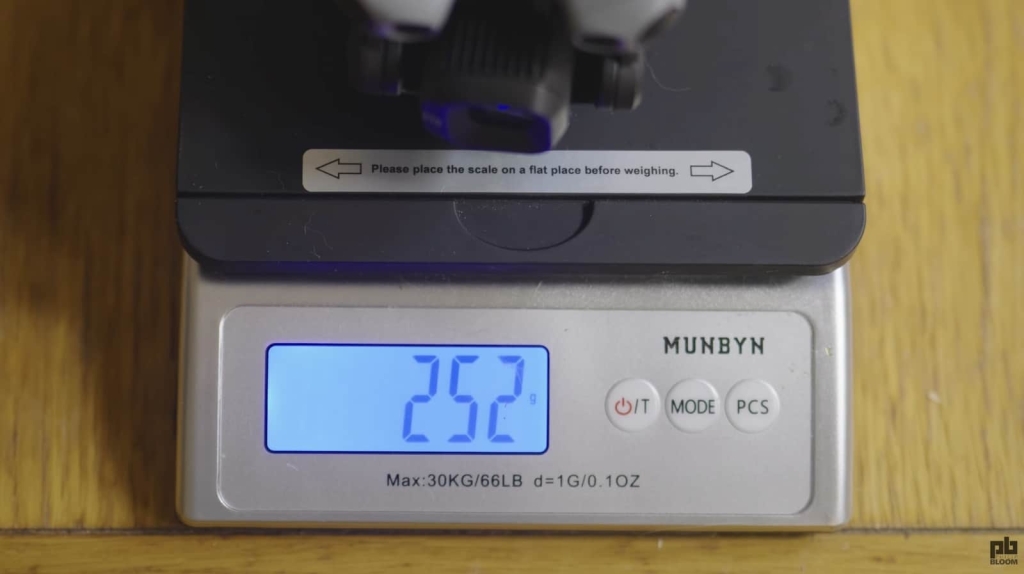
The weight of the Mini 5 Pro itself presents a nuanced and potentially problematic issue. Bloom initially received a pre-production unit that weighed 252 grams (8.89 ounces). While a subsequent replacement unit weighed precisely 250 grams (8.82 ounces), he highlights a growing concern among the user community, with many consumers reporting their purchased units also weighing in at 252 grams. This slight but significant discrepancy, coupled with a new disclaimer on DJI’s website stating a potential weight variance of plus or minus 4 grams, introduces a layer of uncertainty. This variance could have substantial regulatory implications for owners, particularly in regions like the EU, where drones under 250 grams are classified as C0, enjoying more lenient operational guidelines. Bloom acknowledges that his personal scales may not offer 100% accuracy but emphasizes their utility in providing a consistent baseline for comparative measurements. He observed weight differences not only between different Mini 5 Pro units but also among individual batteries. The long-term implications of this weight discrepancy remain to be fully understood, but Bloom anticipates that DJI will likely implement measures to ensure all future production units consistently fall below the 250-gram threshold.
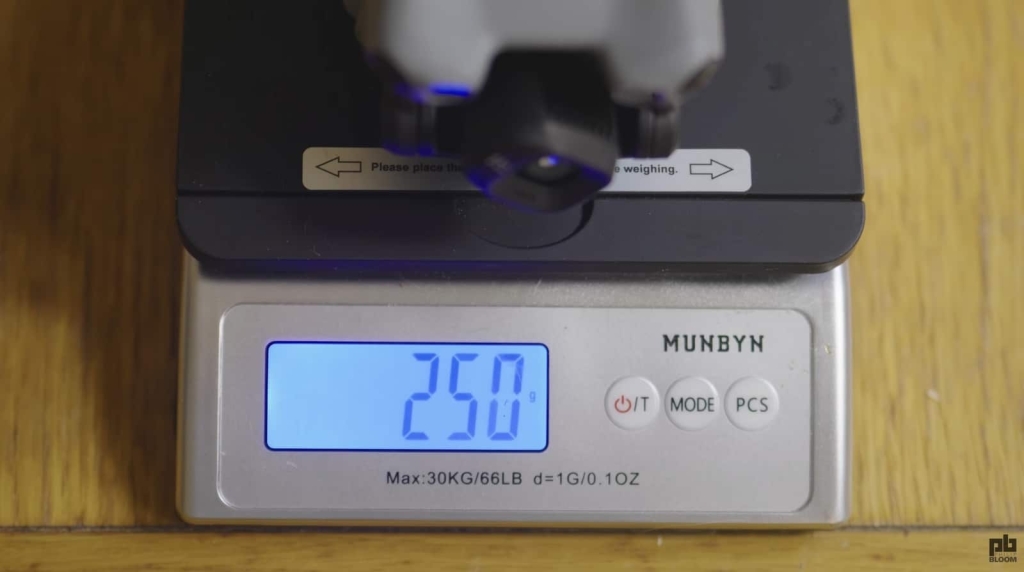
In a humorous anecdote, Bloom recounts receiving a second Mini 5 Pro after an unfortunate incident involving his cat, Jimmy, who sprayed over his original DJI Mini 5 Pro, RC Pro 2, and Mini 4 Pro. He notes, with a touch of irony, that the 5 Pro emits a distinct cat urine odor when heated, a peculiar side effect he jokingly attributes to its Antigravity sponsorship. On a more practical note, Bloom points out that the addition of an ND filter, weighing approximately 1 gram (0.035 ounces), immediately pushes his drone over the 250-gram limit. He expresses frustration with DJI’s return to a “very fiddly” clip-over-the-lens design for ND filters, speculating that this design choice might also be a measure to minimize weight.
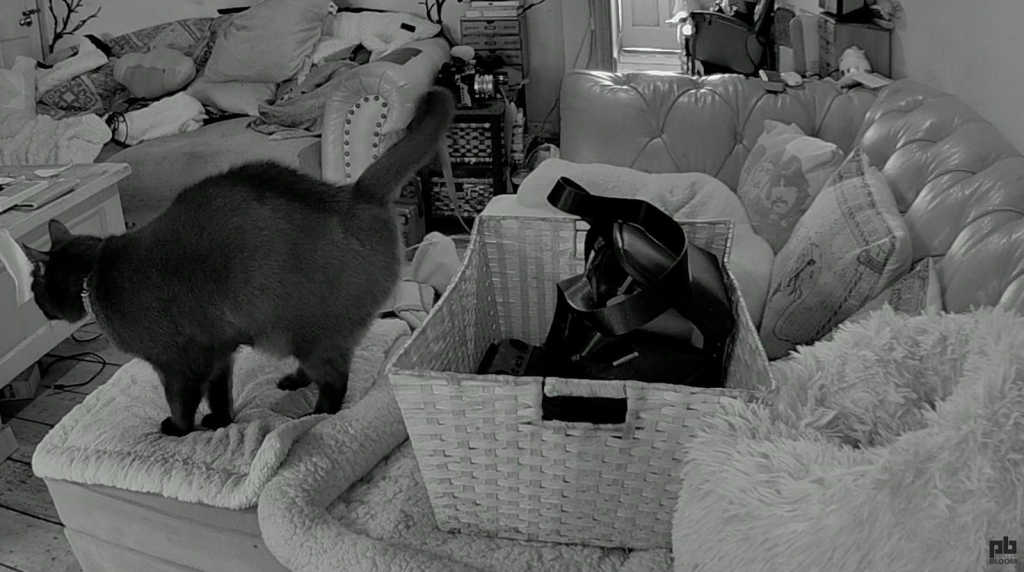
Exceptional Low-Light Performance
Philip Bloom’s low-light tests, conducted in a controlled studio environment, unequivocally confirmed the Mini 5 Pro’s superior performance compared to the Mini 4 Pro, a direct benefit of its larger sensor. The 5 Pro demonstrates enhanced light-gathering capabilities, resulting in cleaner images with less noise in dimly lit conditions. Furthermore, the Mini 5 Pro allows for a one-stop higher ISO setting across all its profiles. Specifically, in D-Log M and HLG modes, the drone can now reach a maximum ISO of 3200, while in normal mode, it extends to an impressive 12,800 ISO. For optimal low-light filming, Bloom strongly advocates for utilizing the D-Log M profile and performing noise reduction in post-production using specialized software like Neat Video. He cautions against using the normal profile for night filming, citing its tendency to produce overly contrasty and sharpened footage. Additionally, he advises against relying on in-camera noise reduction at higher ISOs, as he finds it generates undesirable artifacts. Bloom consistently maintains his sharpness and noise reduction settings at -2 across all his shooting profiles, prioritizing clean, malleable footage.
The advantages of the larger sensor also extend to still photography, translating into improved dynamic range and superior noise performance for photos. This is particularly evident when leveraging the quad-pixel combined 12-megapixel mode. While the full 50-megapixel mode offers a greater level of detail, it comes with a trade-off: increased noise and a reduction in dynamic range, making the 12-megapixel mode often preferable for balanced image quality.
Controller Experience and Innovative Audio Recording
Philip Bloom expresses considerable admiration for the DJI RC Pro 2 controller, lauding its speed, responsiveness, and the clarity of its bright, rotating screen. He describes his overall user experience with the controller as highly positive. However, he notes a significant point of concern for potential Mini 5 Pro buyers: the RC Pro 2 is not currently available as a bundled package option with the Mini 5 Pro. Instead, the drone typically ships with either the standard controller (which requires a smartphone) or the DJI RC2. Despite the sometimes-confusing naming conventions across DJI’s controller lineup, a standout feature of the RC Pro 2, according to Bloom, is its innovative ability to record a scratch track of audio. Crucially, upon initiating video recording, this scratch audio is seamlessly transferred to the camera and integrated directly into the video file. This functionality proves to be an invaluable asset for creators, particularly when filming walk-and-talk style videos, as it significantly simplifies the process of synchronizing audio and video in post-production.
The Mini 5 Pro: A New Benchmark in Compact Drones
The DJI Mini 4 Pro has long held a special place as Philip Bloom’s preferred drone, primarily owing to its exceptional image quality and its advantageous sub-250-gram weight classification. The Air 3S has consistently ranked as a close second in his estimation. The Mini 5 Pro’s adoption of the same high-performance camera as the Air 3S represents a substantial advantage, significantly enhancing its appeal. However, Bloom underscores a critical distinction: the unparalleled benefit of the Air 3S’s dedicated 70mm second camera. This optical zoom lens offers a completely new and distinct perspective that the Mini 5 Pro’s 2x digital zoom, while effective, simply cannot replicate in terms of optical quality and image fidelity. This highlights a key trade-off for users prioritizing versatility in focal lengths.
Ultimately, the decision to invest in the Mini 5 Pro is a highly personal one, resting entirely with the individual pilot. Bloom’s comprehensive review serves as an invaluable resource, meticulously informing potential buyers about the drone’s new features, performance nuances, and his expert opinions. For current owners of the Mini 4 Pro, he advises a careful evaluation of whether the specific new features and enhancements of the Mini 5 Pro are truly essential for their particular creative or professional needs. Despite any minor criticisms, Bloom unequivocally asserts that the Mini 5 Pro stands as the best mini drone currently produced by DJI, acknowledging its impressive capabilities within the stringent sub-250-gram category. Given the drone’s current advanced feature set, he expresses a degree of wonder regarding what further innovations DJI could possibly introduce in future iterations, a testament to the Mini 5 Pro’s current state-of-the-art design and engineering.
